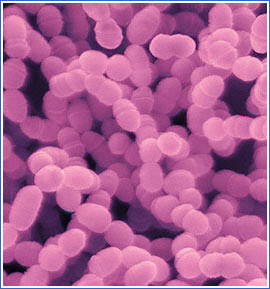Etiology: Bacteria
- Vertical transmission from the primary caregiver, most often the mother, via saliva contact
- Horizontal transmission from family members and care providers, such as in school and daycare settings
The higher the bacteria level in the caregiver's mouth, the earlier the child will become colonized with the cariogenic bacteria.
Caregivers with high bacteria levels usually have:
- High frequency of sugar intake
- Poor oral hygiene
- High levels of dental caries
Evidence supports that caregivers can decrease their risk of passing on cariogenic bacteria to their children by decreasing their own caries levels.
Mutans Streptococci

Caregivers can optimize their oral health and that of their children by:
- Receiving regular comprehensive dental care
- Limiting frequency of sugar in the diet
- Maintaining excellent oral hygiene and using fluoride containing toothpaste
- Using preventive agents, in appropriate age groups, such as:
- Topical fluorides
- Antibacterial mouth rinses, such as chlorhexidine
- Xylitol containing gums
References
Manchanda S, Sardana D, Liu P, et al. Horizontal Transmission of Streptococcus mutans in Children and its Association with Dental Caries: A Systematic Review and Meta-Analysis. Pediatr Dent 2021; 43(1):E1-E12.
Aas JA, Griffen AL, Dardis SR, et al. Bacteria of Dental Caries in Primary and Permanent Teeth in Children and Young Adults. J Clin Microbiol. 2008; 46(4): 1407–1417.
Valm AM. The Structure of Dental Plaque Microbial Communities in the Transition from Health to Dental Caries and Periodontal Disease. J Mol Biol. 2019 Jul 26;431(16):2957-2969.
Weintraub JA et al. Mothers' caries increases odds of children's caries. J Dent Res. 2010; 89(9):954-8.
Zhan L, Tan S, Den Besten P, Featherstone JD, Hoover CI. Factors related to maternal transmission of mutans streptococci in high-risk children-pilot study. Pediatr Dent. 2012; 34(4): e86-91.